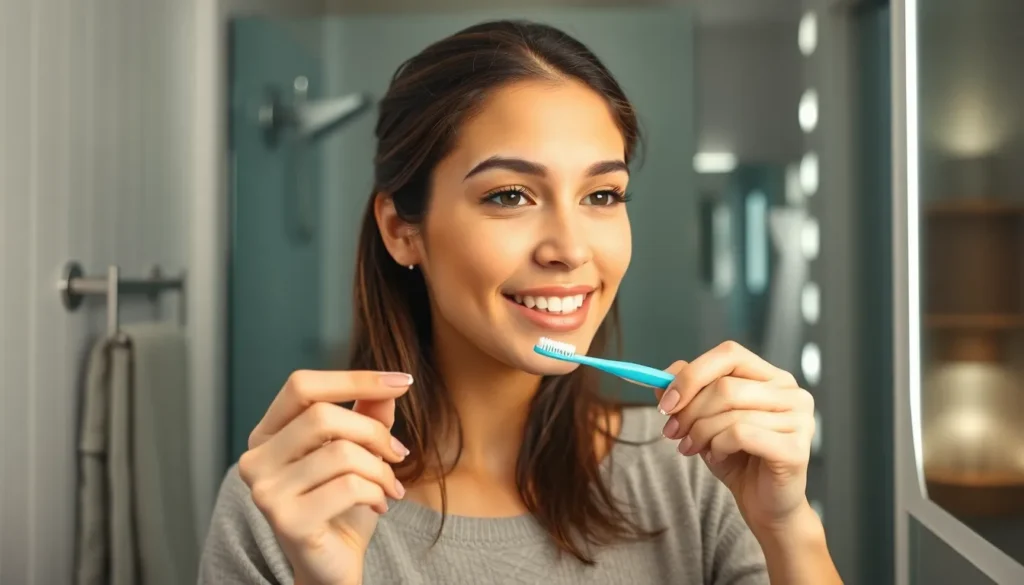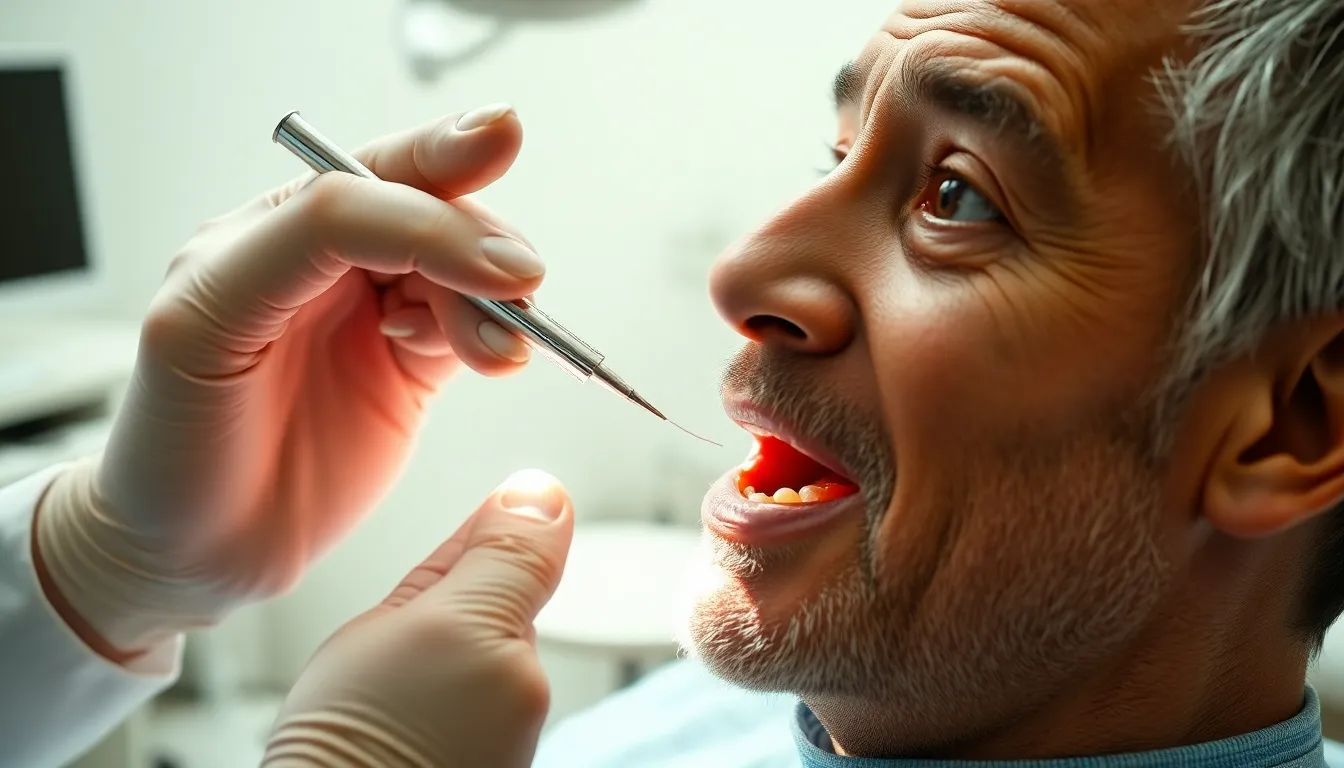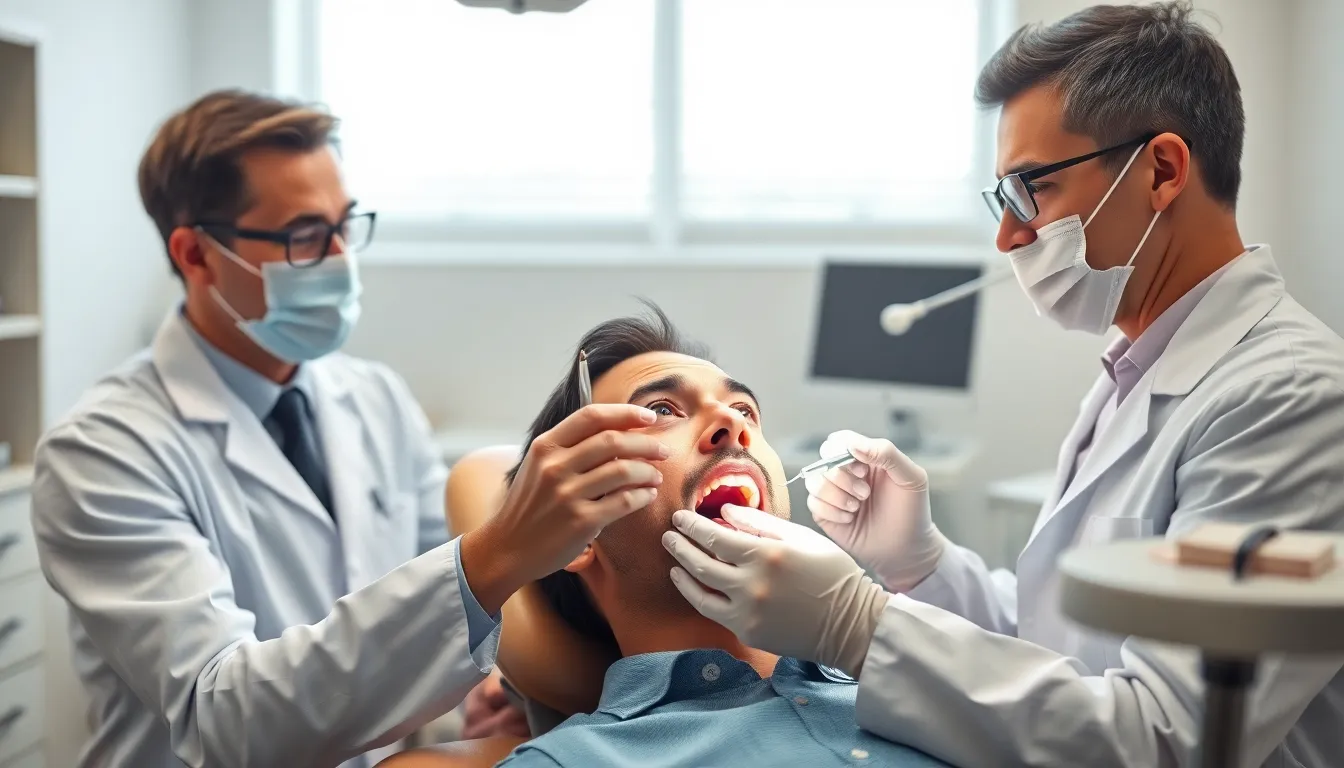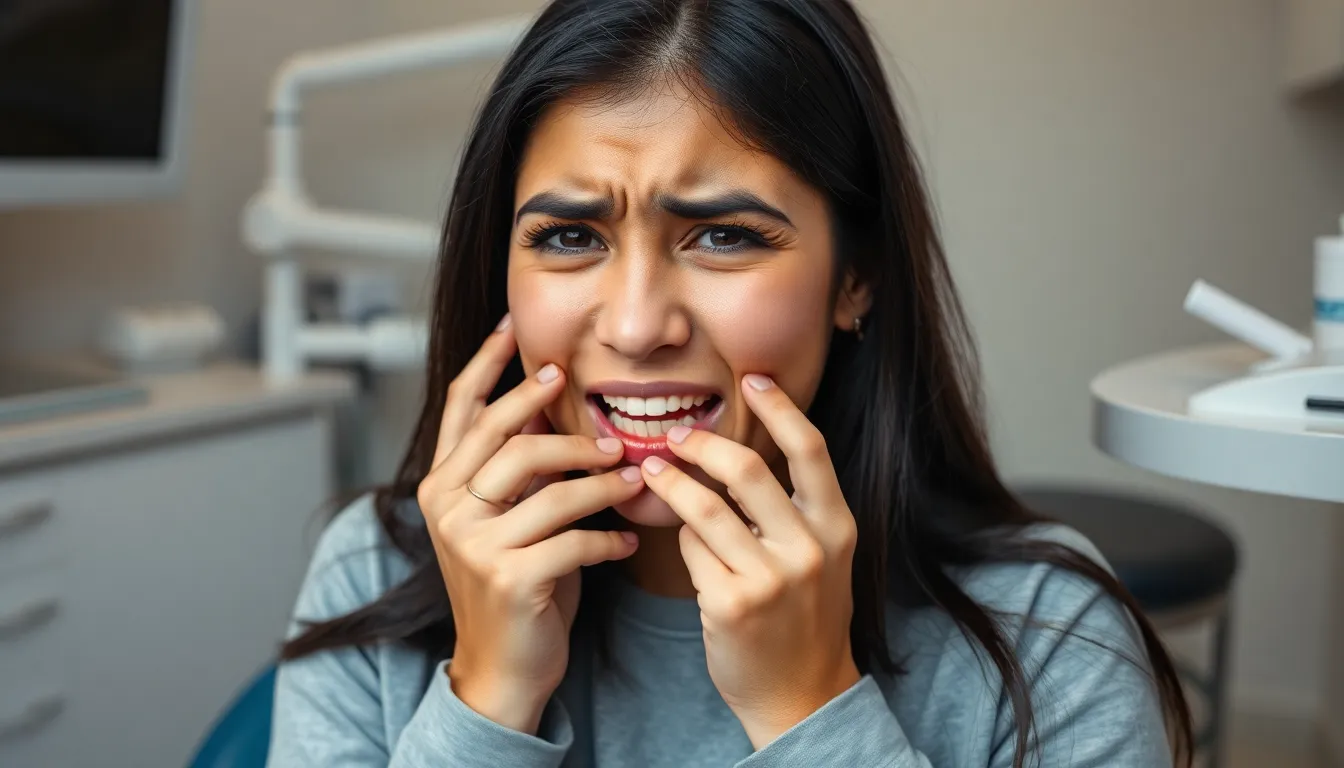Have you noticed your gums bleeding or feeling tender after brushing? Toothbrush scratching gums is a common dental issue that affects millions of people but often goes unaddressed until it becomes painful or leads to more serious problems.
When your toothbrush causes gum irritation, it’s not just uncomfortable—it could signal improper brushing technique, using a toothbrush with bristles that are too firm, or even early signs of gum disease. Understanding why your gums hurt when brushing and how to prevent this damage is essential for maintaining not just your oral health but your overall wellbeing too.
Why Your Toothbrush Might Be Scratching Your Gums
Brushing Technique Problems
Improper brushing technique ranks as the leading cause of gum irritation. Many patients brush with excessive pressure, using a back-and-forth sawing motion that damages sensitive gum tissue. The American Dental Association recommends holding your toothbrush at a 45-degree angle to your gums and using gentle, circular movements rather than aggressive scrubbing. Short, tooth-wide strokes effectively clean teeth without causing trauma to your gums.
Sarah, a dental hygienist patient of mine, came in with receding gums even though her diligent oral care routine. After observing her brushing technique, I noticed she was applying important pressure and brushing horizontally across her gumline. Switching to a gentler approach resolved her gum sensitivity within weeks.
Hard-Bristled Toothbrushes
Toothbrush bristle firmness directly impacts gum health. Hard-bristled brushes can scratch and damage your gum tissue, leading to inflammation, bleeding, and eventual recession. Studies from the Journal of Periodontology show that medium and hard bristles remove more gum tissue than plaque compared to soft bristles. Modern dental professionals overwhelmingly recommend soft-bristled toothbrushes for most adults as they effectively clean teeth while minimizing gum damage.
Worn Out Toothbrush Heads
Your toothbrush head’s condition affects its interaction with your gums. Frayed, splayed bristles become abrasive and can scratch gum tissue even when using proper technique. The Centers for Disease Control and Prevention recommends replacing your toothbrush every 3-4 months or sooner if bristles appear worn. Electric toothbrush heads typically wear out faster than manual brushes due to their higher oscillation rates.
Existing Gum Sensitivity
Sensitive gums react more severely to normal brushing pressure. Conditions like gingivitis, pregnancy-related hormonal changes, and certain medications create gum inflammation that makes even gentle brushing feel uncomfortable. Patients recovering from dental procedures often experience temporary increased sensitivity that requires extra gentle care.
Mr. Johnson, a long-term patient taking blood pressure medication, recently complained about his gums bleeding even though using a soft-bristled brush. His medication was causing gum inflammation, making them more susceptible to irritation from normal brushing. We developed a modified brushing approach using an ultra-soft brush that accommodated his sensitive gums.
Toothpaste Abrasiveness
Toothpaste formulations vary significantly in abrasiveness. Whitening and tartar-control varieties often contain harsher abrasives that can irritate gum tissue when combined with brushing pressure. The Relative Dentin Abrasivity (RDA) scale measures toothpaste abrasiveness from 0-250, with values above 100 potentially causing increased gum irritation. Sensitive formulations typically have lower RDA values (below 70) and prove gentler on gum tissue while still providing adequate cleaning.
Common Causes of Gum Irritation From Brushing

Gum irritation from toothbrushing is a widespread issue that can lead to discomfort, bleeding, and even long-term dental problems. Several exact factors contribute to why your toothbrush might be scratching or irritating your gums during your daily oral care routine.
Bristle Firmness Problems
Toothbrushes with hard or stiff bristles frequently damage delicate gum tissue through repeated abrasion. Clinical studies have confirmed that firm bristles can scrape away gum tissue over time, potentially exposing tooth roots and causing prolonged sensitivity. Many patients visit our practice complaining of tender gums, unaware that their medium or hard-bristled toothbrush is the culprit. Dr. Harris often tells patients, “Your gums aren’t designed to withstand sandpaper treatment twice daily.” Soft-bristled toothbrushes clean just as effectively while being significantly gentler on your gum tissue, reducing the risk of irritation and recession.
Improper Brushing Technique
Brushing too aggressively creates traumatic injury to your gums, leading to inflammation, tenderness, and bleeding. Excessive force while brushing can cause gum recession where tissue pulls away from teeth, creating pockets that trap bacteria and increase your risk of gum disease. Gentle circular motions clean teeth effectively without damaging gums. One patient shared how she’d brushed vigorously her entire life thinking it meant cleaner teeth, only to discover at age 45 that she’d created important gum recession requiring treatment. Proper technique involves holding your brush at a 45-degree angle to the gumline and using light pressure—just enough to feel the bristles against your teeth and gums.
Signs Your Toothbrush Is Damaging Your Gums
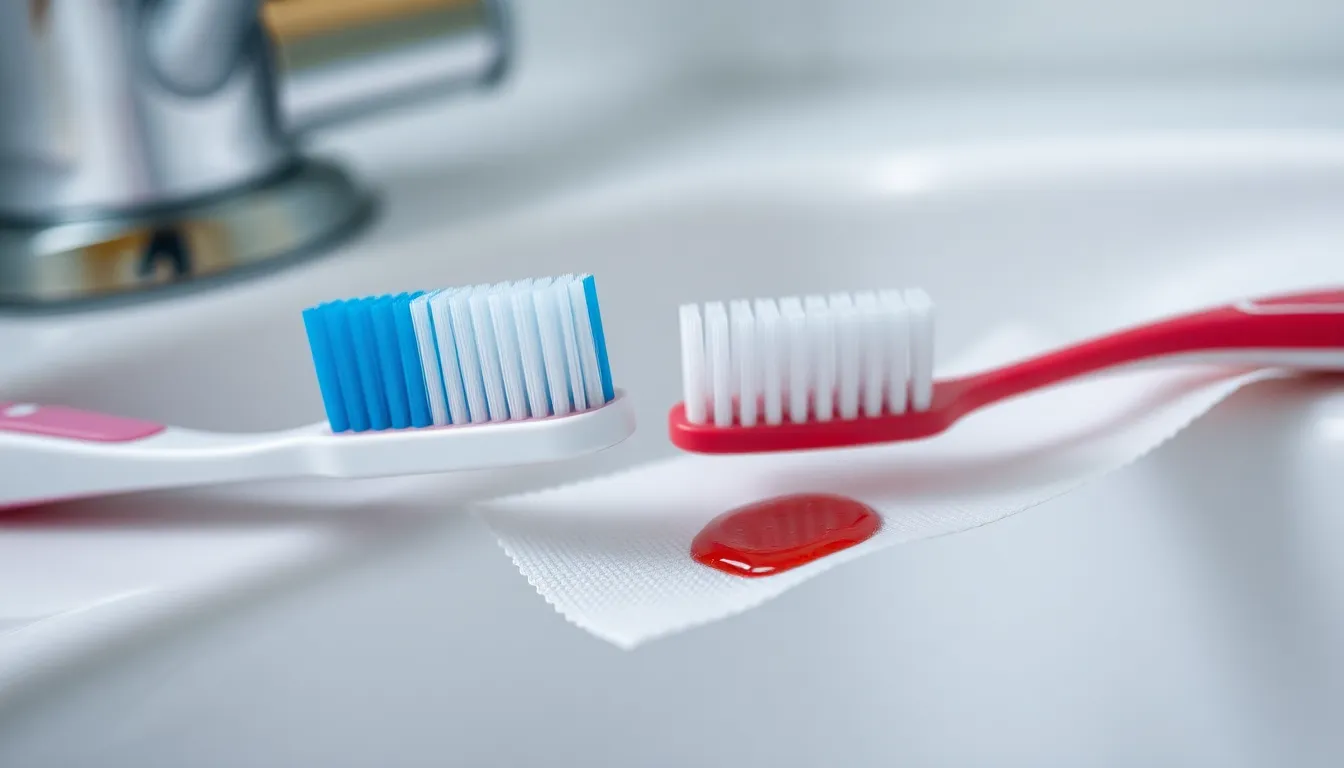
Your toothbrush might be causing more harm than good if you’re experiencing discomfort after brushing. Recognizing the early warning signs of gum damage can help you adjust your oral care routine before serious problems develop.
Bleeding When Brushing
Bleeding gums during or immediately after brushing serves as one of the first indicators that your toothbrush is damaging your gum tissue. This bleeding occurs when irritated or injured gum tissue responds to the physical trauma of aggressive brushing. Many patients report seeing pink or red in the sink while spitting after brushing, yet they continue their harmful brushing habits unaware of the connection. Dr. Harris often tells his patients, “Healthy gums don’t bleed from normal brushing—it’s your body’s way of signaling that something’s wrong with either your technique or your gum health.”
Gum Recession
Gum recession appears as the gradual pulling away of gum tissue from your teeth, exposing more of the tooth surface and eventually the sensitive root area. This condition creates an uneven, asymmetrical gum line where teeth appear longer than normal. The exposed roots aren’t protected by enamel, making them vulnerable to decay and sensitivity. Sarah, a long-time patient at our practice, noticed her gums receding primarily on the side she brushed most vigorously with her medium-bristled toothbrush. After switching to a soft-bristled brush and gentler technique, her condition stabilized, though the recession couldn’t be reversed without surgical intervention.
Persistent Sensitivity
Tooth sensitivity that lingers or intensifies over time often indicates enamel erosion from overly aggressive brushing. This sensitivity typically manifests as sharp, sudden pain when consuming hot, cold, or sweet foods and beverages. The discomfort occurs because hard brushing wears down protective enamel, exposing the dentin layer underneath with its microscopic tubules that connect to nerve endings. Dr. Harris explains, “Many patients unknowingly create their own sensitivity by scrubbing their teeth like they’re cleaning bathroom tiles—teeth need gentle care, not vigorous scrubbing.” Clinical observations show that patients who modify their brushing technique and switch to desensitizing toothpaste typically experience important relief within two weeks.
How to Choose a Gentle Toothbrush
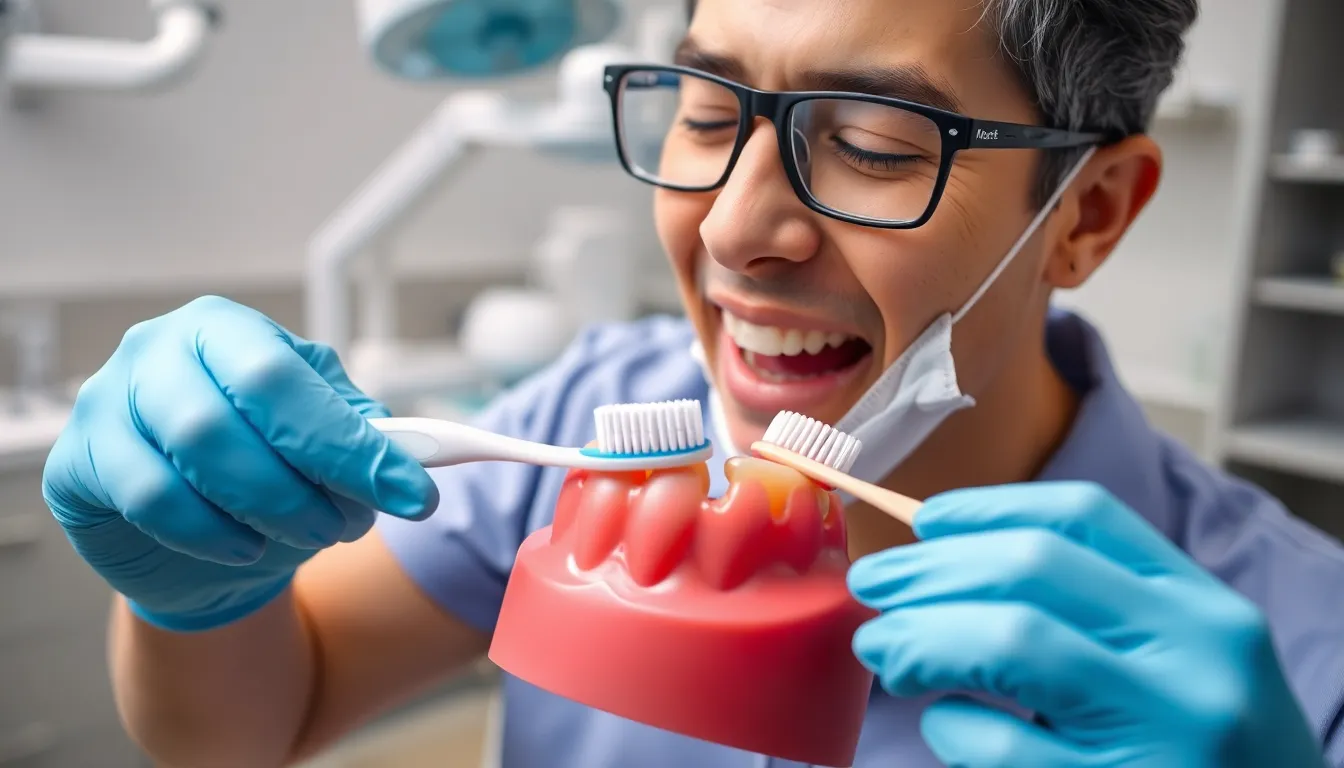
Selecting the right toothbrush is crucial for preventing gum damage while maintaining effective oral hygiene. Your choice of toothbrush can significantly impact gum health and comfort during brushing.
Soft vs. Medium vs. Hard Bristles
Soft bristles provide the ideal balance between cleaning effectiveness and gum protection. They’re specifically designed to remove plaque and food particles without scratching or irritating delicate gum tissue. Dental professionals consistently recommend soft-bristled toothbrushes as the safest option for most people.
Medium and hard bristles pose a considerable risk to your gum health. These firmer bristles can cause gum abrasion with regular use, leading to soreness, inflammation, and potentially irreversible gum recession over time. Dr. Todd B. Harris notes, “I’ve seen countless patients with receding gums due to years of brushing with hard bristles, thinking they were cleaning more effectively, when in reality they were gradually damaging their gum tissue.”
Electric vs. Manual Options
Electric toothbrushes offer built-in features that can help protect your gums from excess pressure. Many modern electric models include pressure sensors that alert you when you’re brushing too hard, automatically reducing power or flashing a warning light. These smart features make electric options particularly beneficial for people who tend to brush aggressively.
Manual toothbrushes require more attention to technique but can be equally gentle when used correctly. Focus on using a light touch and gentle circular motions rather than vigorous back-and-forth scrubbing. One patient shared, “After experiencing bleeding gums for months, my dentist showed me how I was applying too much force with my manual toothbrush. Switching to gentler motions completely resolved my gum irritation within weeks.”
The handle design of your toothbrush also matters for pressure control. Ergonomic handles with non-slip grips help maintain proper control, reducing the likelihood of applying excessive force during brushing. Regardless of whether you choose electric or manual, the combination of soft bristles and proper technique provides the most effective cleaning while protecting your gum tissue from damage.
Proper Brushing Techniques to Protect Your Gums
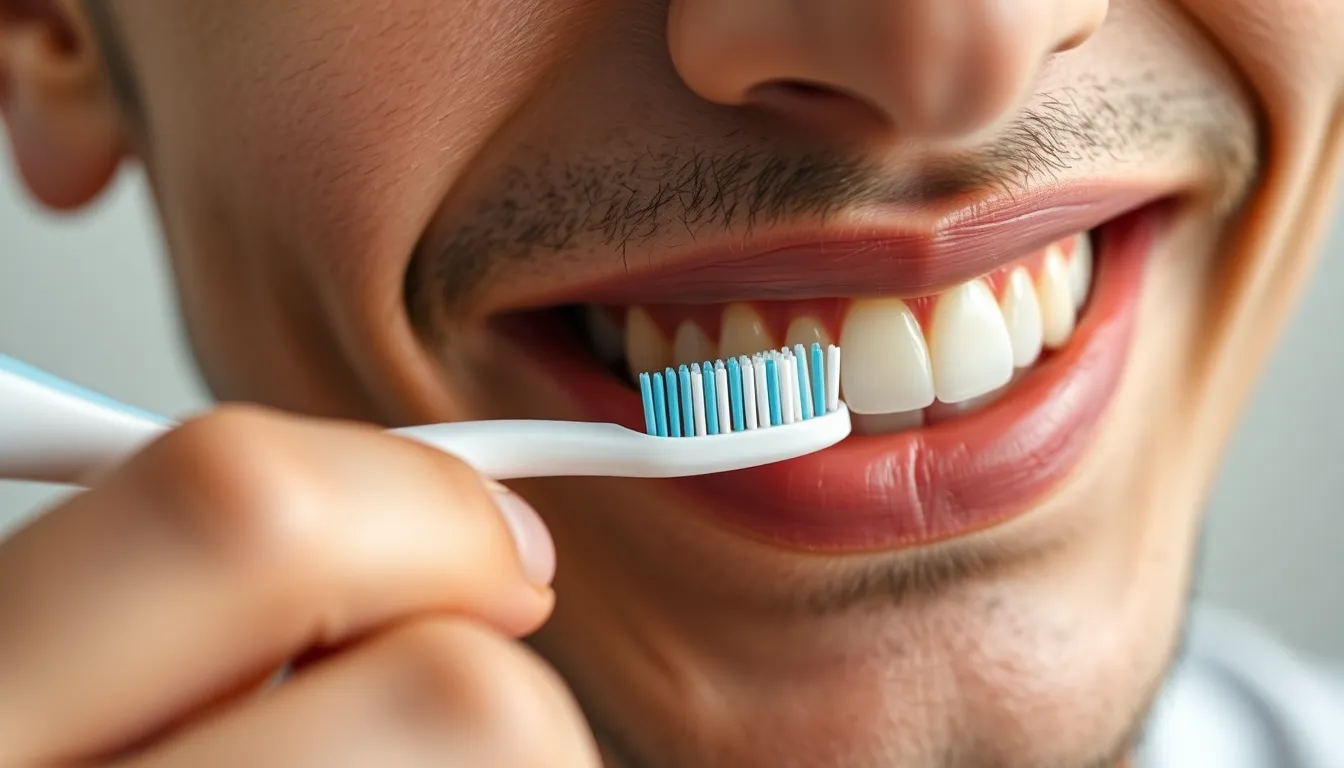
Protecting your gums from toothbrush damage requires exact brushing techniques that balance effective cleaning with gentle care. Mastering these methods prevents irritation while maintaining optimal oral health.
The 45-Degree Angle Method
The 45-degree angle technique positions your toothbrush at the perfect angle to clean effectively without damaging gum tissue. Place the bristles where your teeth meet your gums, tilting the brush at a 45-degree angle to allow bristles to reach both tooth surfaces and the crucial gum margin. This angle targets plaque accumulation zones while avoiding direct harsh contact with sensitive gum tissue. Many patients report important improvement in gum health after adopting this method, including reduced bleeding and irritation during brushing sessions.
Appropriate Pressure and Motion
Gentle pressure forms the foundation of gum-friendly brushing practices. Pressing too hard scratches delicate gum tissue and damages enamel over time, creating unnecessary trauma. Apply light pressure—just enough to feel the bristles against your teeth without bending them excessively. Combine this gentle touch with circular or elliptical movements rather than aggressive back-and-forth scrubbing. These rounded motions effectively remove plaque while being considerably gentler on gum tissue. Soft or extra-soft bristled toothbrushes complement this technique by providing thorough cleaning without the abrasiveness of firmer options. Patients who’ve switched to this approach often notice their gums look healthier and feel less sensitive within just two weeks of consistent practice.
When to See a Dentist About Gum Irritation
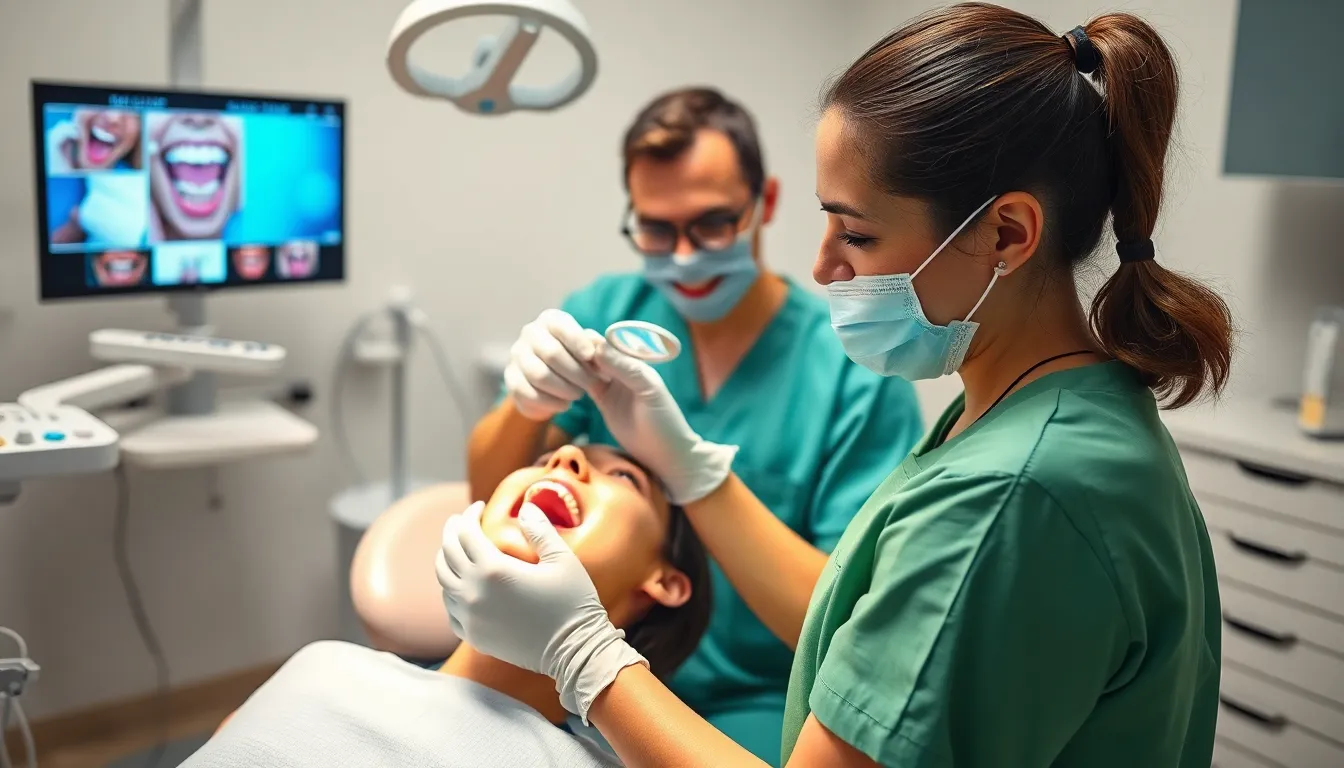
Persistent gum irritation requires professional attention, especially when home care measures don’t resolve the issue. Dental professionals can determine if your irritated gums stem from brushing technique problems or indicate an underlying condition like gingivitis or periodontitis.
Signs That Warrant a Dental Visit
Red, swollen gums that bleed easily during brushing aren’t normal and often signal the early stages of gum disease. Pain or soreness that continues for more than a week deserves professional evaluation to prevent progression to more serious conditions. Gum recession, where tissue pulls away from teeth, indicates potential damage from aggressive brushing or developing periodontal disease. Visible signs of infection such as pus between teeth and gums or persistent bad breath require immediate dental attention.
What to Expect at Your Appointment
Your dentist will conduct a comprehensive examination of your gums, checking for inflammation, bleeding points, and measuring pocket depths around teeth. X-rays might be taken to assess bone health beneath the gumline and detect any hidden issues contributing to your symptoms. Treatment recommendations typically include professional cleaning to remove built-up plaque and tartar that home brushing can’t eliminate. Educational guidance on proper brushing techniques using a soft-bristled toothbrush at a 45-degree angle often forms part of your care plan.
Professional Treatments for Gum Irritation
Scaling and root planing provides deep cleaning below the gumline for patients with more advanced irritation or early periodontal disease. Antibiotic treatments may be prescribed to address bacterial infections contributing to gum inflammation. Surgical interventions become necessary in severe cases where important gum recession or bone loss has occurred. Regular maintenance appointments help monitor improvement and prevent recurrence of gum problems.
Recommended Products for Sensitive Gums
Soft-bristled toothbrushes provide the gentlest cleaning experience for sensitive gums while still effectively removing plaque. These brushes minimize trauma to delicate gum tissue that may already be irritated from previous aggressive brushing. Many dentists specifically recommend extra-soft bristles for patients experiencing gum recession or sensitivity.
Electric toothbrushes with pressure sensors offer important advantages for those with sensitive gums. These devices automatically alert you when you’re applying too much force, helping prevent the excessive pressure that causes gum abrasion. Built-in timers also ensure you brush for the recommended two minutes without overbrushing particular areas.
Toothpaste formulated for sensitive teeth contains less abrasive ingredients than standard varieties. These gentler formulations clean effectively without causing additional irritation to vulnerable gums. Some sensitive toothpastes also contain potassium nitrate or stannous fluoride that help reduce nerve sensitivity while strengthening enamel.
Interdental brushes with coated wires clean between teeth without scratching or irritating the gums. Their small, soft bristles reach areas that regular toothbrushes miss, making them ideal for cleaning around sensitive gum lines. Using these properly sized brushes prevents the need to force floss into tight spaces, which can cut or damage gums.
Water flossers present an excellent alternative for those whose gums bleed easily with traditional floss. The gentle water stream removes debris between teeth and below the gum line without causing trauma. Adjustable pressure settings allow you to customize the intensity based on your comfort level and gum sensitivity.
Antimicrobial mouth rinses with minimal alcohol content can help reduce bacteria without causing the burning sensation that irritates sensitive gums. These rinses complement gentle brushing techniques by reaching areas that might be painful to brush thoroughly. Regular use helps maintain gum health while providing a less aggressive cleaning option.
Replacing your toothbrush every three months ensures the bristles remain in optimal condition. Frayed or worn bristles become more abrasive over time and can scratch gum tissue, leading to increased sensitivity and potential recession. Even soft-bristled brushes become problematic when they’re past their useful life.
Conclusion
Taking care of your gums is just as important as cleaning your teeth. By switching to a soft-bristled toothbrush applying gentle pressure and using proper circular motions you’ll significantly reduce the risk of gum damage.
Pay attention to warning signs like bleeding sensitivity and recession. These symptoms shouldn’t be ignored as they may indicate your brushing technique needs adjustment or an underlying dental issue requires attention.
Remember that the right tools matter. Invest in quality soft-bristled brushes pressure-sensing electric models and gentle toothpaste formulations to protect your gum tissue while maintaining excellent oral hygiene.
Your gums deserve gentle care. With these simple adjustments to your daily routine you’ll preserve not just your smile but your overall oral health for years to come.
Frequently Asked Questions
Why do my gums bleed when I brush my teeth?
Bleeding gums during brushing often indicates gum inflammation (gingivitis) or using improper brushing techniques. You might be applying too much pressure or using a hard-bristled toothbrush that traumatizes the gum tissue. Early gum disease can also cause bleeding, as bacteria build-up leads to inflammation. If bleeding persists despite improved brushing habits, consult your dentist as it could signal more serious periodontal issues.
How do I know if I’m brushing too hard?
Signs of brushing too hard include bleeding gums, receding gumlines, increased tooth sensitivity, and worn-out toothbrush bristles that splay outward after just a few weeks of use. Your gums may also look red and inflamed after brushing. A good rule of thumb is to hold your toothbrush with just your fingertips rather than a full grip to naturally reduce pressure.
What type of toothbrush is best for sensitive gums?
Soft-bristled toothbrushes are ideal for sensitive gums. They effectively clean teeth while minimizing damage to gum tissue. Electric toothbrushes with pressure sensors can be beneficial as they alert you when you’re applying too much force. Look for toothbrushes with rounded bristle tips and those specifically designed for sensitive gums. Replace your toothbrush every three months to prevent bristle deterioration.
What is the correct way to brush to avoid gum damage?
Hold your toothbrush at a 45-degree angle to your gumline. Use gentle, circular or short back-and-forth motions rather than aggressive scrubbing. Brush for two full minutes, spending equal time on all quadrants of your mouth. Apply light pressure—enough to feel the bristles against your gums but not enough to cause discomfort. Don’t forget to clean your tongue to reduce bacteria.
Can toothpaste cause gum irritation?
Yes, some toothpastes contain abrasive ingredients or strong flavoring agents that can irritate sensitive gums. Whitening toothpastes are particularly likely to cause irritation due to their higher abrasiveness. Ingredients like sodium lauryl sulfate (SLS) can also trigger sensitivities in some people. Consider switching to toothpastes labeled for sensitive teeth, which typically contain milder ingredients while still providing effective cleaning.
How can I reduce gum sensitivity when brushing?
To reduce gum sensitivity, switch to a soft-bristled toothbrush, use gentle brushing pressure, and choose toothpaste formulated for sensitive teeth. Rinse with warm salt water to soothe irritated gums. Ensure you’re brushing at least twice daily to prevent plaque buildup that worsens sensitivity. Stay hydrated and maintain a balanced diet rich in vitamin C to support gum health. Allow at least 30 minutes after acidic foods before brushing.
When should I see a dentist about my gum problems?
See a dentist if you experience persistent bleeding gums, severe or ongoing pain, noticeable gum recession, loose teeth, pus between teeth and gums, or bad breath that doesn’t improve with good oral hygiene. Also seek professional help if your gums remain swollen, red, or tender for more than two weeks despite improved brushing habits. Early intervention can prevent minor gum issues from developing into serious periodontal disease.
Are electric toothbrushes better for sensitive gums?
Electric toothbrushes can be beneficial for sensitive gums, especially models with pressure sensors that alert you when you’re brushing too hard. They provide consistent cleaning motions that reduce the tendency to scrub aggressively. Studies show they can remove more plaque with less effort than manual brushes. However, technique matters regardless of brush type—even with an electric toothbrush, use gentle pressure and proper positioning.
How often should I replace my toothbrush?
Replace your toothbrush or electric toothbrush head every three months, or sooner if the bristles become frayed, discolored, or splayed outward. Using a worn-out toothbrush reduces cleaning effectiveness and can damage gum tissue. Also replace your toothbrush after you’ve been sick to prevent reinfection. Some toothbrushes have color-changing indicators that signal when replacement is needed.
Can gum recession from brushing be reversed?
Unfortunately, gum recession caused by aggressive brushing cannot be naturally reversed once it occurs. The gum tissue doesn’t regenerate to cover the exposed tooth roots. However, you can prevent further recession by improving your brushing technique and using a soft-bristled toothbrush. For significant recession, dentists may recommend treatments like gum grafting to cover exposed roots and prevent additional damage. Early intervention is key.

